It’s 2025, and most enterprise technology leaders aren’t building the future—they’re managing the past, revealed a new research report published by HFS Research, in collaboration with digital transformation consultancy Publicis Sapient.
“Despite years of digital ambition and billions in modernisation budgets, the hard truth remains: technical debt has become the single biggest barrier to innovation, agility, and growth,” the report said, referring to HFS estimates that the Global 2,000 companies are carrying $1.5–2 trillion in accumulated tech debt.
The study was based on insights from more than 600 IT and business leaders across industries.
Modernising Applications Takes More Investment
According to the report, modernising core applications requires significant investment, yet only 30% of firms report being fully modernised. While 42% say modernisation is in progress, 25% remain heavily reliant on legacy systems, and 4% are at risk of obsolescence.
Most enterprise leaders trust AI to deliver better modernisation outcomes, with 80 per cent believing that AI will increase the success of these efforts. The remaining respondents, however, hold a contrasting view.
About 22% of respondents are actively deploying AI across multiple IT functions. The rest are either not considering AI, experimenting with it in select functions, exploring but not yet implementing it, or are sceptical about its potential impact in the sector.
A majority of leaders see multiple barriers to AI adoption, ranging from talent to integration challenges. About 55% cite a shortage of skilled talent, 41% struggle with integrating AI into legacy systems, and 40% point to data quality and governance issues.
The report revealed that enterprises are shifting to AI-driven service models primarily to escape the limitations of legacy systems, accelerate innovation, and enhance operational agility.
Cost savings, improved customer and employee experiences, and the need for a fresh approach also rank high. Additionally, technology debt, competitive pressure, and regulatory changes are pushing organisations to adopt AI-led, Services-as-Software models that promise greater efficiency, adaptability, and transformation.
The need for a change
Organisations are increasingly shifting to AI-driven service models, including Services-as-Software, due to a variety of pressing reasons. According to the report, nearly half (49%) cite a legacy system focus, where existing IT services are more about maintaining outdated systems than driving transformation.
Technology debt concerns 36% of organisations that feel the current model fails to reduce it, while 32% are responding to competitive pressures to adopt AI and automation. Lastly, 22% are driven by market or regulatory changes.
Decline of Manual Labour
The traditional labour-based outsourcing model, particularly staff augmentation, is rapidly declining, with 35% more respondents expecting its use to decrease rather than increase, the report revealed. This model, built on rate-card pricing, has long offered flexibility and control but is now being replaced by more efficient, AI-powered alternatives.
Technology-enabled services, where staff are supported by proprietary tools and accelerators, are seeing a modest rise, while platform-led services and AI-led agentic services are gaining stronger momentum due to their scalability, automation, and outcome-driven models.
Platform-led models, using cohesive platforms for delivery, and AI-led services, which augment human capabilities with AI agents, are being adopted for their efficiency, cost-effectiveness, and enhanced service potential.
The most significant shift is toward Services-as-Software (SaaS), with 74% of respondents expecting its adoption to rise. This model, unlike traditional SaaS, delivers services through advanced AI-led software, reducing human intervention and offering scalable, consistent, and license/subscription-based commercial models.
As organisations look beyond 2025, the transition from manual, human-centric delivery to technology-first, autonomous systems marks a clear inflection point in the evolution of service models.
Break the Tech Deb
To break free from the cycle of tech debt, enterprises must rethink their entire approach to technology, instead of applying AI as a surface-level fix.
The report outlines five bold moves: treat tech debt like financial debt by tracking and paying it down strategically; re-architect systems around AI rather than layering it onto legacy infrastructure; partner with providers that offer productised, AI-driven capabilities instead of manpower; shift to outcome-based or subscription-driven commercial models; and embrace AI-native ways of working by redesigning roles, governance, and delivery systems.
“This isn’t just a technology issue—it’s a structural trap. And much of the $1.5 trillion IT services industry is designed to keep enterprises in it,” the report said.
For decades, organisations have relied on outsourcing, staff augmentation, and automation. However, these legacy methods often increase complexity instead of reducing it, leading to stagnation with many offshore workers.



